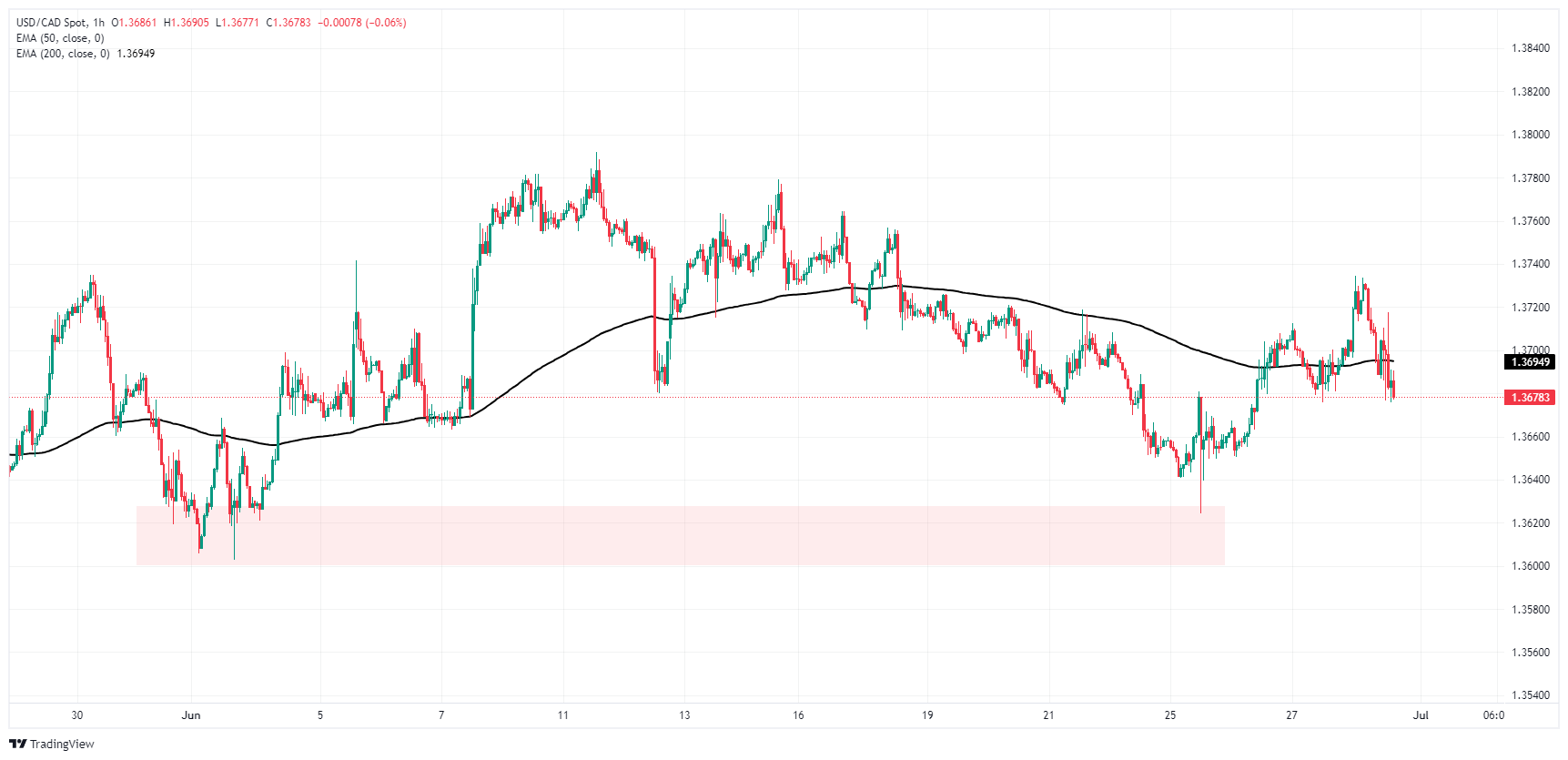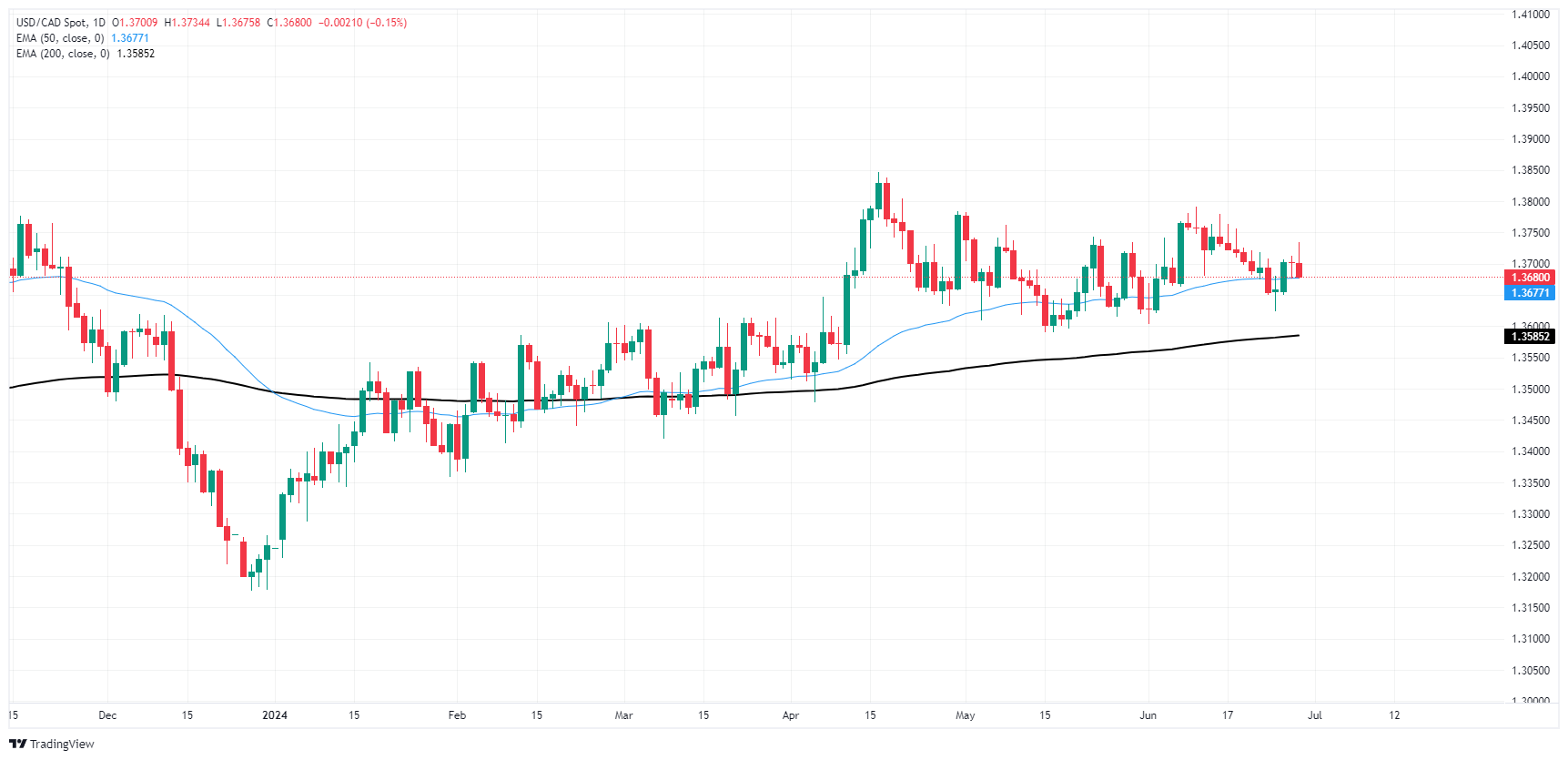- Canadian Dollar bolstered by rising market sentiment.
- Canada posted a 0.3% uptick in GDP, propping up CAD.
- US PCE inflation also ticked lower, further bolstering rate cut hopes.
The Canadian Dollar (CAD) found some room on the high side on Friday, pushing up by a scant tenth of a percent against the US Dollar amid choppy intraday price action after key economic data broadly met market expectations. Canadian Gross Domestic Product (GDP) ticked higher and US Personal Consumption Expenditure Price Index (PCE) inflation figures cooled slightly.
Canada posted a slight gain in GDP growth in April, rebounding from the previous month’s flat print. A stacked US data docket also generally met market expectations, though US Personal Spending failed to meet expectations despite a post-revision improvement.
Economic Indicator
Gross Domestic Product (MoM)
The Gross Domestic Product (GDP), released by Statistics Canada on a monthly and quarterly basis, is a measure of the total value of all goods and services produced in Canada during a given period. The GDP is considered as the main measure of Canadian economic activity. The MoM reading compares economic activity in the reference month to the previous month. Generally, a high reading is seen as bullish for the Canadian Dollar (CAD), while a low reading is seen as bearish.
Read more.Daily digest market movers: Canadian GDP rebounds, US inflation continues to ease for now
- Canadian MoM GDP posted a 0.3% increase in April, meeting market expectations and recovering from the previous month’s 0.0%.
- US PCE Price Index inflation also eased to 2.6% YoY in May, meeting market forecasts and cooling from the previous 2.8%.
- Market bets of a September rate cut from the Federal Reserve (Fed) have ticked higher post-PCE. According to the CME’s FedWatch Tool, rate markets are pricing in 66% odds of at least a quarter-point rate trim from the Fed on September 18, up from a flat 60% pre-PCE inflation.
- University of Michigan (UoM) 5-year Consumer Inflation Expectations also ticked down to 3.0% in June, down from previous 3.1%.
- UoM Consumer Sentiment Index for June also surged to 68.2 from 65.6, vaulting over median market forecasts of 65.8.
Canadian Dollar PRICE Today
The table below shows the percentage change of Canadian Dollar (CAD) against listed major currencies today. Canadian Dollar was the strongest against the Japanese Yen.
| USD | EUR | GBP | JPY | CAD | AUD | NZD | CHF | |
|---|---|---|---|---|---|---|---|---|
| USD | -0.09% | -0.05% | 0.08% | -0.16% | -0.33% | -0.16% | 0.12% | |
| EUR | 0.09% | 0.05% | 0.14% | -0.05% | -0.26% | -0.07% | 0.22% | |
| GBP | 0.05% | -0.05% | 0.10% | -0.12% | -0.29% | -0.11% | 0.03% | |
| JPY | -0.08% | -0.14% | -0.10% | -0.26% | -0.38% | -0.22% | -0.05% | |
| CAD | 0.16% | 0.05% | 0.12% | 0.26% | -0.18% | 0.00% | 0.14% | |
| AUD | 0.33% | 0.26% | 0.29% | 0.38% | 0.18% | 0.19% | 0.33% | |
| NZD | 0.16% | 0.07% | 0.11% | 0.22% | -0.01% | -0.19% | 0.14% | |
| CHF | -0.12% | -0.22% | -0.03% | 0.05% | -0.14% | -0.33% | -0.14% |
The heat map shows percentage changes of major currencies against each other. The base currency is picked from the left column, while the quote currency is picked from the top row. For example, if you pick the Canadian Dollar from the left column and move along the horizontal line to the US Dollar, the percentage change displayed in the box will represent CAD (base)/USD (quote).
Technical analysis: Canadian Dollar recovers ground on Friday, sends USD/CAD into familiar levels
The Canadian Dollar found a bid on Friday, gaining ground against the majority of its major currency peers as markets get set to wrap up a relatively sedate trading week. The CAD gained around one-tenth of one percent against the US Dollar on Friday and climbed nearly one-quarter of one percent against the broadly-battered Japanese Yen.
USD/CAD briefly found a fresh high for the week near 1.3735 early Friday before settling back into familiar near-term lows near 1.3675. CAD strength has briefly halted a recent upswing in the pair on a Greenback bid, sending USD/CAD into a rough near-term corkscrew around the 200-hour Exponential Moving Average (EMA) near the 1.3700 handle.
USD/CAD hourly chart
USD/CAD daily chart
Canadian Dollar FAQs
The key factors driving the Canadian Dollar (CAD) are the level of interest rates set by the Bank of Canada (BoC), the price of Oil, Canada’s largest export, the health of its economy, inflation and the Trade Balance, which is the difference between the value of Canada’s exports versus its imports. Other factors include market sentiment – whether investors are taking on more risky assets (risk-on) or seeking safe-havens (risk-off) – with risk-on being CAD-positive. As its largest trading partner, the health of the US economy is also a key factor influencing the Canadian Dollar.
The Bank of Canada (BoC) has a significant influence on the Canadian Dollar by setting the level of interest rates that banks can lend to one another. This influences the level of interest rates for everyone. The main goal of the BoC is to maintain inflation at 1-3% by adjusting interest rates up or down. Relatively higher interest rates tend to be positive for the CAD. The Bank of Canada can also use quantitative easing and tightening to influence credit conditions, with the former CAD-negative and the latter CAD-positive.
The price of Oil is a key factor impacting the value of the Canadian Dollar. Petroleum is Canada’s biggest export, so Oil price tends to have an immediate impact on the CAD value. Generally, if Oil price rises CAD also goes up, as aggregate demand for the currency increases. The opposite is the case if the price of Oil falls. Higher Oil prices also tend to result in a greater likelihood of a positive Trade Balance, which is also supportive of the CAD.
While inflation had always traditionally been thought of as a negative factor for a currency since it lowers the value of money, the opposite has actually been the case in modern times with the relaxation of cross-border capital controls. Higher inflation tends to lead central banks to put up interest rates which attracts more capital inflows from global investors seeking a lucrative place to keep their money. This increases demand for the local currency, which in Canada’s case is the Canadian Dollar.
Macroeconomic data releases gauge the health of the economy and can have an impact on the Canadian Dollar. Indicators such as GDP, Manufacturing and Services PMIs, employment, and consumer sentiment surveys can all influence the direction of the CAD. A strong economy is good for the Canadian Dollar. Not only does it attract more foreign investment but it may encourage the Bank of Canada to put up interest rates, leading to a stronger currency. If economic data is weak, however, the CAD is likely to fall.
Information on these pages contains forward-looking statements that involve risks and uncertainties. Markets and instruments profiled on this page are for informational purposes only and should not in any way come across as a recommendation to buy or sell in these assets. You should do your own thorough research before making any investment decisions. FXStreet does not in any way guarantee that this information is free from mistakes, errors, or material misstatements. It also does not guarantee that this information is of a timely nature. Investing in Open Markets involves a great deal of risk, including the loss of all or a portion of your investment, as well as emotional distress. All risks, losses and costs associated with investing, including total loss of principal, are your responsibility. The views and opinions expressed in this article are those of the authors and do not necessarily reflect the official policy or position of FXStreet nor its advertisers. The author will not be held responsible for information that is found at the end of links posted on this page.
If not otherwise explicitly mentioned in the body of the article, at the time of writing, the author has no position in any stock mentioned in this article and no business relationship with any company mentioned. The author has not received compensation for writing this article, other than from FXStreet.
FXStreet and the author do not provide personalized recommendations. The author makes no representations as to the accuracy, completeness, or suitability of this information. FXStreet and the author will not be liable for any errors, omissions or any losses, injuries or damages arising from this information and its display or use. Errors and omissions excepted.
The author and FXStreet are not registered investment advisors and nothing in this article is intended to be investment advice.
Recommended content
Editors’ Picks

Gold falls amid a possible de-escalation of US-China tensions Premium
Gold pulled back from its all-time high of $3,500 per troy ounce reached earlier on Tuesday, as a resurgent US Dollar and signs of easing tensions in the US–China trade dispute appeared to draw sellers back into the market.

EUR/USD retreats to daily lows near 1.1440
EUR/USD loses the grip and retreats to the 1.1440 zone as the Greenback’s rebound now gathers extra steam, particulalry after some positive headlines pointing to mitigating trade concerns on the US-China front on Tuesday.

GBP/USD deflates to weekly lows near 1.3350
GBP/USD loses further momentum and recedes to the 1.3350 zone on Tuesday, or two-day troughs, all in response to the frmer tone in the US Dollar and encouraging news from the US-China trade scenario.

3% of Bitcoin supply in control of firms with BTC on balance sheets: The good, bad and ugly
Bitcoin disappointed traders with lackluster performance in 2025, hitting the $100,000 milestone and consolidating under the milestone thereafter. Bitcoin rallied past $88,000 early on Monday, the dominant token eyes the $90,000 level.

Five fundamentals for the week: Traders confront the trade war, important surveys, key Fed speech Premium
Will the US strike a trade deal with Japan? That would be positive progress. However, recent developments are not that positive, and there's only one certainty: headlines will dominate markets. Fresh US economic data is also of interest.

The Best brokers to trade EUR/USD
SPONSORED Discover the top brokers for trading EUR/USD in 2025. Our list features brokers with competitive spreads, fast execution, and powerful platforms. Whether you're a beginner or an expert, find the right partner to navigate the dynamic Forex market.



